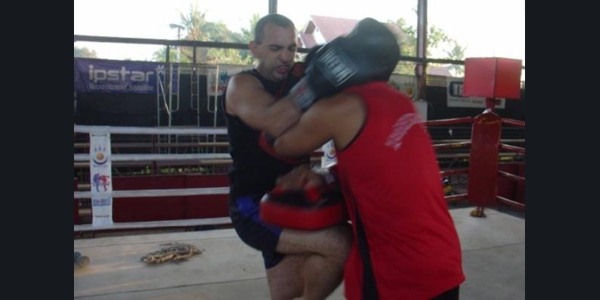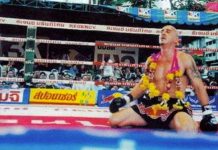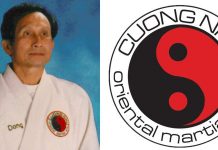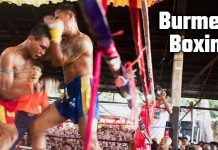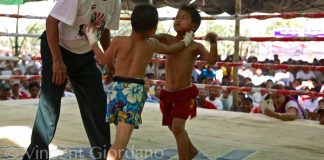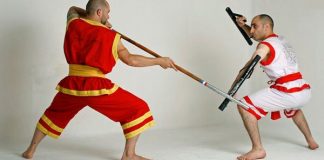“You can gain extra power on your kicks by throwing your kicking arm down, but you need to protect your face with a cross arm defense.” Explained my Muay Lao trainer, Adjarn Ngern, at the national kick boxing stadium in Vientiane, Lao.
In Tae Kwan Do and a lot of other kicking arts, the right hand comes down when you kick. This is the moment when a good boxer should step in and punch the kicker in the face. Adjarn Ngern was the first person ever to show me the cross arm defense, basically wrapping your free arm across your face to cover up when you kick. This gives you safety and power.
It was my first day of learning Muay Lao and I wondered what else they had to offer.
For years I had been training off and on in Thailand and Cambodia. I had heard that the national sport in Lao was called Muay Lao, but I didn’t know anyone who had actually gone there for training.
Lao is a sleepy country. The population is less than six million and nearly all of the development is in the capitol, Vientiane, which is a cute, peaceful city which feels like a small town in the US from the 1950s. Apart from the docile feeling in the air, Lao is surprisingly good for training. There is a weight lifting gym located in a tenement block, beside the national sports stadium, where you can do your strength training for a small donation of fifty cents per day. You can get a bed in a dormitory for $3 a day or stay in a hotel, as I do, private room, TV, cable, hot water, private bath, and air-conditioning, for $12 per night. Food is excellent in Lao, French, Thai, Chinese, Indian, Lao or western, and most meals in a restaurant will cost you about $2.50. You could probably live even cheaper if you wanted to eat the street food which would probably run you less than a dollar per meal. In Lao, they accept US dollars, Thai Baht, or their local currency, Kip. Muay Lao training costs 200 thai Baht, about $6 USD per session, for private training.
The travel guides were all dead wrong about the Muay Lao training. Most books said it was held at the national sports stadium in Vientiane. Actually, the Muay Lao training is held at the National Muay Lao stadium, which is located about fifteen or twenty minutes outside of the city. The stadium boasts a full size ring, a row of kick bags, and a row of uppercut bags mounted on the wall. The coaches are excellent in the ring working the pads with you.
Adjarn Ngern, the head coach of the Lao National Muay Lao Team, told me that Muay Lao is a much smaller sport in Lao than is Muay Thai in Thailand. Professional fights are only held in the National Stadium twice per month. There are only a handful of registered professional fighters in the whole country.
“How is Muay Lao different than Muay Thai?” I asked.
“It’s exactly the same.” Said the Adjarn.
“Cambodians are angry about the name Muay Thai. They feel they invented kickboxing and it should be called by the Cambodian name, Bradal Serey, not Muay Thai. What do you think of that?”
Without a second’s hesitation he answered, “Muay Thai was invented in Cambodia, but Thailand has the money and got famous.”
The Adjarn had me start with warm up exercise, a very complete stretching routine which covered all parts of the body, especially the neck and shoulders where injuries can occur in kick boxing.
He watched me shadow boxing for a few minutes then asked, confused “Do you also kick?” I think your fist martial art stays with you forever. You can take the boy out of Brooklyn, but you can’t take the Brooklyn out of the boy. No matter how long I train in Asia, I will always look like a boxer or street fighter.
We readjusted my stance. He didn’t want me to hold my hands next to my face like I do in boxing. Instead, he wanted the lead hand out in front and a bit lower than what I do for boxing. He also didn’t want the hands touching my face in case I was punched or kicked and it would force me to hit myself.
Next, we worked combinations on the uppercut bag one, two, and upper cut switching off left hand upper cut and right hand upper cut. He was excellent about correcting my form while I trained. Adjarn made me turn out my back foot on straight punches, and go up on my toes at impact. On the Upper cut, he also had me up on my toes, and made me turn my heel in.
We transitioned to kicks, on the bag. The important point which he kept stressing here was to get up on the toes of your base foot, and rotate the foot with the kick. Next, you must be careful to twist your hip and butt into the kick. The leg must travel parallel to the ground, and strike at an almost ninety degree angle, kicking IN not UP like in a Tae Kwan Do kick. Of course, in Muay Lao, like in Muay Thai, the roundhouse strikes with the shin.
Other combinations we worked on required me to kick off the front leg. A lot of teachers tell you to hop, scoot the front leg back, then kick with the front leg. Adjarn Ngern wanted me to minimize this hopping and leg shuffling. He told me to only to slide my left leg back slightly, then kick off of it. The right leg didn’t really move at all. It felt awkward at first, but it was a good technique. It was faster and less exhausting than the more common hop and shuffle. It just took a lot of practice for me to get it. To save even more time, he showed me that when the left leg hit, instead of bringing it back, just bring it straight down to the ground. Now you are in close so immediately throw an overhand elbow with the right arm.
With the knee kick, Adjarn Ngern always wanted to lead hand straight out. You could use this hand to measure distance, and time your strike. When your left hand just about makes contact with the opponent, step in and decimate him with your right knee. The extended arm is also a good defensive tactic. This way if your opponent takes this opportunity to throw an elbow or a punch, you could catch it with your lead hand, long before it hits you. In fact, you could catch/deflect his elbow with your floating lead hand, and still complete your knee strike. In that instance, the power would be multiplied by the fact that your opponent would be coming forward with his own strike. This would be one of those knees to the solar plexus which could end a fight.
Once again, when reaching out with your left/lead hand, you could either use your right hand to do the cross face defense, as you did in the kick, or you could throw the right hand down and back to add extra power to the knee. The lead hand can be used to grab the back of the opponent’s head and pull him into the knee strike. And remember to go up on the toes of the base leg to get those last few extra inches of extension and power.
After you have thrown the knee, you can step trough with an elbow because you have already closed the distance.
To help me get up on my toes and swing my hips, the coach and one of the fighters stood behind me, twisting my legs and hips and trying to get my position right. It was a lot to remember, and there was nothing natural about having two men twisting and prodding my body while I practiced. It was like a dance lesson gone wrong.
Adjarn had me hold the bag and do left right knee combinations, fast. But, he kept stressing that each of the knees had to be a real technique, a solid knee strike. Most people who practice the fast alternating knees on the bag just barely touch the bag with each knee, then shuffle and throw the next one. But this type of exercise has nothing to do with real fighting. It’s not just aerobics. In a fight every technique must be right. Every knee strike must count.
Blocking, the knee can be used several different ways. One common option is to block a kick by brining the knee straight up, and allowing your shin to hit the opponent’s shin as he kicks. A more offensive block is to quickly raise your knee higher than the attacker’s kicking leg, and bring you knee straight down into his leg, hitting him with your knee on his thing, just above his knee. This could render his leg useless for the rest of the fight. Once, again, after you have blocked, you have already closed distance, so the quickest follow up is to bring your leg straight back to the floor and step in with a close elbow.
Some coaches tell you to knee strike with your foot at a 90 degree angle. Other coaches tell you to point your foot at the floor. Both camps claim that they get more power. I don’t think there is a clear answer on which is better. This coach wanted the foot pointed at the ground.
With both a knee and a kick one more thing to remember is to arch your back to get the extra extension and power.
The coach taught me a fake. He did a shuffle, as if getting ready to kick with his left, lead foot, but instead, he threw a punch to the face.
“If you see the punch coming you can use Teep to protect yourself because your leg is longer than his arm.” Explained Adjarn Ngern, teaching the push kick.
When executing a push kick, the toes must be curled back and you strike with the ball of the foot. It is really hard to do because you have to develop the muscles in your feet. I can’t curl my toes back at will. Teep can also be done with the heel of the foot, but Adjarn Ngern claimed that it wasn’t as powerful. Muay Thai Boran practitioners find that the heel of the foot works just fine, however.
Very few people in Lao speak any English at all. Most people in Vientiane, including Adjarn Ngern, speak excellent Thai. So I was able to communicate with him in Thai. Thus far, I was impressed with Adjarn Ngern and how modern his training and thinking was. He was one of the few coaches I had worked with in Asia who could really analyze and discuss the sport of fighting. But his old-school training suddenly showed when he did the thing where he put rope in his mouth and used his neck to lift a heavy bucket full of cement.
He invited me to try it next, but one look at his used saliva dripping off the rope made me thing twice about it.
“Aren’t you going to boil that rope?” I asked.
We opted to move on to the next phase of training instead.
In Muay Lao, as in Muay Thai the fighters often lock up, grappling. They grab each other behind the back of the neck and struggle to get dominance over the opponent. It is amazing how many throws a good fighter can do from this position. A significant component in learning Muay Lao is practicing grappling from the neck.
The goal in Muay grappling is to achieve the dominant position, which means, getting your two hands on the inside. The two fighters start with one in and one out, then they compete to get both hands inside. Once you have both hands inside, you can plant your elbows in your opponent’s chest, leverage his head and take him. In any type of fighting, if you want to control a man, grabbing the back of his neck is good because then you are pulling against muscle, not bone. Grabbing higher on the head gives you extended leverage, multiplying your power. Post your hips back, bend at the knees and bring your entire body weight to bear on his neck muscles.
Adjarn Ngern showed me how you could grab the back of the head with one hand and slide your hand down under the elbow for leverage. Then in one quick, jerking motion, you could pull down on the head and push up on the elbows at the same time and throw the man. In wrestling never let your legs stand square, one foot beside the other or you have no base no balance and can easily be knocked down.
Another exercise we worked on, one man held his hands behind his back and the other man tried to throw him. It is a simple technique, step out on the right, throw on the left. Step out on the left, throw on the right.
Training in Lao was just one more piece of the puzzle. The art of kickboxing is widely practiced in Lao, Cambodia, Thailand, and Burma. Only by training in all four countries could I get a good overview of the art. So, Burma was next.

